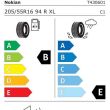What do I need to know when choosing summer tyres?
Summer tyres must provide the driver with precise control and excellent grip on wet and dry road surfaces. Summer tyres are built to withstand greater speeds and higher road temperatures. In contrast to winter tyres, summer tyres have a lower tread pattern depth to ensure greater stability of the tryres on asphalt. The lower rolling resistance results in higher fuel efficiency.
The tread pattern of summer tyres has a greater contact surface with the road surface. This is why it is very important that when driving on wet roads, summer tyres would be able to direct water and moisture away from the area between the tyre and the road surface. As a rule, the amount of precipitiation is higher in the summer and autumn months compared to winter and spring. Therefore, tyre manufacturers recommend replacing the summer tyres already at a remaining tread depth of 3-4 mm, even though the permitted limit is 1.6 mm.
When buying summer tyres, you should also be aware that the price of the product is generally also an indicator of quality. For example, the braking distance for premium class summer tyres on wet road surfaces can be 40% higher compared to more affordable tyres – this is a lot! In addition, the purchase should not be based solely on the EU energy label on the tyre.






